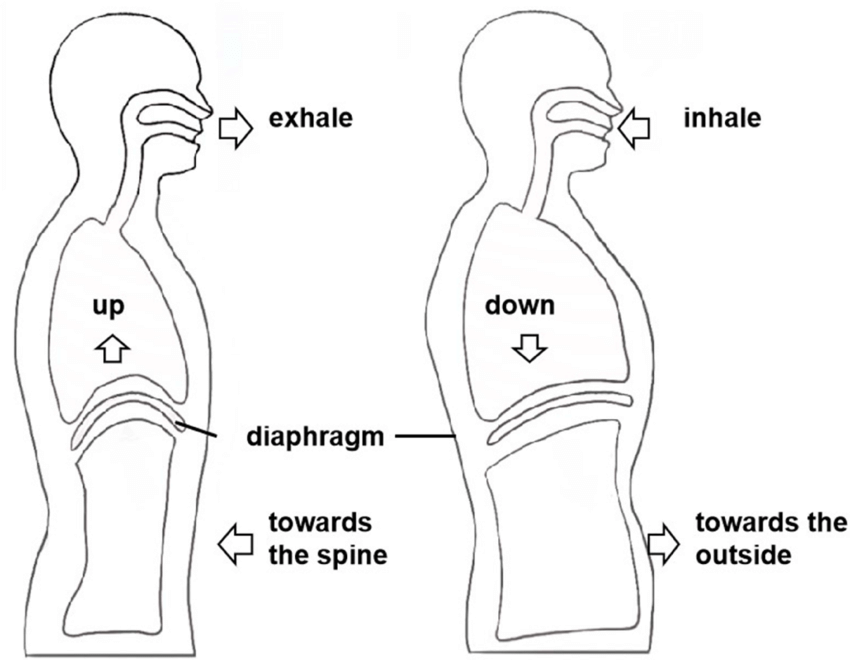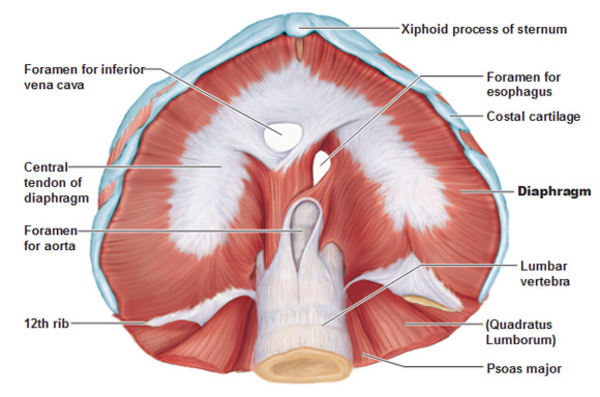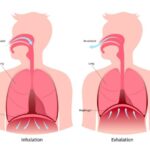Breathing is something we do every moment of our lives, yet few of us think about how we breathe or how it affects our overall health. At the center of this vital function is the diaphragm, a dome-shaped muscle that plays a crucial role in respiration, posture, digestion, and even stress management.
The diaphragm plays a crucial role beyond just breathing—it impacts how efficiently we take in oxygen, stabilizes the core during movement, and helps regulate internal pressure. In physical therapy, optimizing diaphragmatic function is essential for improving posture, reducing muscle tension, and enhancing overall movement efficiency. When working properly, the diaphragm supports relaxation, boosts circulation, and improves athletic performance. However, dysfunction in this muscle can lead to inefficient breathing, increased stress, and greater physical strain.
Physical therapists often incorporate breathing techniques and exercises to restore proper diaphragmatic function, promoting better movement and overall well-being.
Read more articles:
Can Sleep Deprivation Increase Your Pain?
Restore My Sleep, Restore My Health!
Health and Wellness: What Every Patient Should Know
Get Over Yourself
Jumpstart Your Health: New Years Habits for a Healthy New You
Our Core: The Functional Pressure System

Diaphragmatic Breathing for Pain Management and Relaxation
Harnessing the power of the diaphragm through controlled breathing techniques can provide significant benefits for pain relief and relaxation. Whether it’s reducing muscle tension, improving circulation, or activating the body’s natural relaxation response, diaphragmatic breathing is a simple yet powerful tool for overall well-being.
1. Improved Oxygenation and Pain Relief
Deep breathing increases oxygen intake, ensuring that muscles and tissues receive adequate oxygen for healing and function. Proper oxygenation helps reduce the perception of pain by decreasing the production of stress-related hormones and promoting relaxation. This is especially beneficial for individuals experiencing chronic pain, tension headaches, or muscle fatigue.
2. Reduction in Muscle Tension
Many people unconsciously hold tension in their shoulders, neck, and lower back due to shallow, inefficient breathing. Engaging the diaphragm fully encourages the relaxation of surrounding muscles, helping to release tension in commonly affected areas. This can be particularly helpful for those who experience pain due to poor posture or prolonged stress.
3. Pain Perception and the Nervous System
The way we breathe directly impacts the nervous system. Shallow breathing keeps the body in a heightened state of alertness, activating the sympathetic nervous system (the body’s fight-or-flight response). Diaphragmatic breathing, on the other hand, stimulates the parasympathetic nervous system and vagus nerve, which helps counteract stress and reduce the body’s pain response. Engaging the diaphragm fully can lower cortisol levels and increase endorphin release, naturally reducing pain perception.
4. Enhanced Blood Circulation for Healing
Deep breathing improves circulation by encouraging better blood flow throughout the body. This enhanced circulation helps deliver oxygen and nutrients to tissues, aiding in recovery and reducing inflammation. Those suffering from conditions like fibromyalgia, arthritis, or general muscle soreness may experience relief from incorporating diaphragmatic breathing into their routine.
5. Stress Reduction and Emotional Well-Being
Chronic stress often manifests as physical discomfort, leading to headaches, tension, and fatigue. Diaphragmatic breathing is a well-documented way to lower stress levels, promoting emotional balance and relaxation. By focusing on slow, controlled breaths, individuals can calm the mind, reduce anxiety, and improve overall mental clarity.
6. Mindfulness and Focus
Breath work is a core component of mindfulness and meditation practices. Focusing on deep breathing helps bring awareness to the present moment, reducing distractions and improving mental focus. This can be particularly beneficial for those dealing with anxiety, insomnia, or difficulty concentrating.
By regularly practicing diaphragmatic breathing, individuals can experience both physical and emotional relief. Next, we’ll explore specific techniques to strengthen and engage the diaphragm effectively.

Techniques to Strengthen and Utilize the Diaphragm
Incorporating diaphragmatic breathing into daily life can enhance relaxation, reduce stress, and improve overall health. The following techniques can help strengthen the diaphragm, making breathing more efficient and controlled.
1. Deep Diaphragmatic Breathing
A foundational exercise, deep diaphragmatic breathing focuses on engaging the diaphragm rather than the chest for fuller, more effective breaths.
How to Practice:
- Sit or lie down in a comfortable position.
- Place one hand on your chest and the other on your abdomen.
- Breathe in deeply through your nose, allowing your abdomen to expand while keeping your chest still.
- Exhale slowly through your nose, feeling your abdomen lower.
- Repeat for 5–10 minutes, focusing on smooth, controlled breaths.
This technique can be used as a daily practice for stress management or incorporated into warm-up and cool-down routines for athletes.
2. Box Breathing (Four-Square Breathing)
This technique enhances focus and relaxation by promoting a steady, rhythmic breath cycle.
How to Practice:
- Inhale deeply through the nose for a count of four.
- Hold the breath for four counts.
- Exhale slowly through the nose for four counts.
- Pause for four counts before inhaling again.
- Repeat for several minutes.
- As you progress, you can increase the duration of the inhale, hold, and exhale phases.
This method is particularly useful during high-stress situations, as it quickly calms the nervous system and sharpens mental clarity.
3. 4-7-8 Breathing for Relaxation
This technique is commonly used to reduce stress and improve sleep quality by slowing the breath and promoting deeper relaxation.
How to Practice:
- Inhale through your nose for four counts.
- Hold the breath for seven counts.
- Exhale slowly through the nose for eight counts.
- Repeat for 4–5 cycles, gradually increasing duration if comfortable.
By extending the exhalation, 4-7-8 breathing helps activate the parasympathetic nervous system, reducing stress and tension in the body.
4. Pursed-Lip Breathing for Lung Efficiency
This technique is often recommended for individuals with respiratory conditions like asthma or COPD to improve oxygen intake and regulate airflow.
How to Practice:
- Inhale deeply through your nose.
- Purse your lips as if blowing out a candle.
- Exhale slowly and steadily through pursed lips, making the exhalation twice as long as the inhalation.
- Repeat several times, focusing on controlled breath release.
Pursed-lip breathing strengthens the diaphragm and improves breathing efficiency, particularly for those with respiratory challenges.
5. Progressive Muscle Relaxation with Breath Control
Combining diaphragmatic breathing with muscle relaxation can further reduce tension and stress.
How to Practice:
- Take a deep breath in, tightening a specific muscle group (e.g., shoulders, hands, legs).
- Exhale slowly while releasing the muscle tension.
- Move through different muscle groups, from head to toe, coordinating breath with relaxation.
This method is particularly effective for those experiencing muscle tension, chronic pain, or stress-related discomfort.
6. Breath work in Movement (Yoga & Pilates Integration)
Breath control is a fundamental component of yoga and Pilates, emphasizing coordinated movement and breathing patterns.
How to Practice:
- Inhale deeply when lengthening or stretching.
- Exhale while engaging the core or transitioning into a new position.
- Maintain smooth, intentional breaths throughout the practice.
Integrating diaphragmatic breathing into movement-based activities enhances control, stability, and relaxation, making physical exercises more effective.
Making Diaphragmatic Breathing a Habit
To experience long-term benefits, diaphragmatic breathing should become a daily habit. Consider incorporating it into moments of stress, before sleep, during exercise, or as part of a mindfulness practice.
By strengthening the diaphragm and improving breath control, these techniques can help optimize lung function, reduce stress, and support overall well-being. In the final section, we’ll discuss the lasting impact of a well-functioning diaphragm on health and performance.
The Lasting Impact of a Well-Functioning Diaphragm
The diaphragm is far more than just a breathing muscle—it plays a central role in overall health and well-being. By practicing diaphragmatic breathing techniques regularly, you can improve your body’s ability to manage stress, reduce fatigue, and support a healthier posture. Whether through deep breathing exercises, progressive muscle relaxation, or mindful breath control during movement, integrating these techniques into daily life can create lasting benefits.
Investing time in strengthening and using your diaphragm effectively is a simple yet powerful way to improve both physical and mental health. As science continues to highlight the importance of breathwork, making diaphragmatic breathing a regular practice can be a game-changer for relaxation, recovery, and overall vitality.
By understanding and harnessing the power of the diaphragm, you can take control of one of the most fundamental aspects of well-being—your breath.
Take charge of your health by optimizing your breath! At IPA Physio, our expert physical therapists specialize in diaphragmatic training to improve core stability, reduce tension, and enhance overall movement efficiency. Whether you’re recovering from an injury, looking to improve athletic performance, or simply want to breathe and move better, we’re here to help.
Schedule a session with IPA Physio today and experience the transformative benefits of proper breathing and movement. Your body—and your breath—will thank you! Contact us now to get started.
Sources:
Agostoni, E., & D’Angelo, E. (2013). Respiratory muscles and their mechanics. Springer Science & Business Media.
Bordoni, B., & Marelli, F. (2016). The diaphragm as a stabilizer. Journal of Bodywork & Movement Therapies, 20(2), 324-329. https://doi.org/10.1016/j.jbmt.2015.11.008
Hodges, P. W., & Gandevia, S. C. (2000). Activation of the human diaphragm during a repetitive postural task. The Journal of Physiology, 522(1), 165-175. https://doi.org/10.1111/j.1469-7793.2000.00165.x
Jerath, R., Edry, J. W., Barnes, V. A., & Jerath, V. (2006). Physiology of long pranayamic breathing: Neural, respiratory and cardiovascular correlates. Medical Hypotheses, 67(3), 566-571. https://doi.org/10.1016/j.mehy.2006.02.042McConnell, A. K. (2013). Respiratory muscle training: Theory and practice. Elsevier Health Sciences.






